Are Extinct & Living Dinosaurs Just Gray?
Posted by: Loren Coleman on July 25th, 2009
What colors are the extinct gigantic reptiles, just gray? Or maybe dull brown? Obviously, if you look at some toys your kids are playing with, then dinosaurs must have been orange, red and blue.
Then maybe too, dinosaurs aren’t extinct, if some people are correct.
Since an earlier version of this discussion was posted over a recent holiday weekend, some of you may have missed it. Here is a quick revisit of the issue of colors, living dinosaurs, and more, with several new images added.
One fun resource I did want to mention, even though I don’t have a review copy yet, is Karl Shuker’s book shown below. It looks like a good one.
Needless to say, those that study such things can’t even tell us what colors extinct dinosaurs were.
Furthermore, we don’t know whether any of the reports from South America, Asia, and Africa of Mokele-mbembe and their kin are even really living dinosaurs.
The schools of thought clearly divide along strict lines of thought here. Bernard Heuvelmans, Karl Shuker, and others think Mokele-mbembe and other similar cryptids are sauropods and their relatives, truly living dinosaurs. Based on those theories, thus, you will find dinosaur models in creationist museums reinforcing the notion that humans and dinos roamed the Earth together. On the other hand, Darren Naish, yours truly, and some others tend to not think in terms of “living dinosaurs” as part of zoological reality (and I’m not talking about the birds-are-dinos argument here, by the way).
As I said in a field guide passage about reports of dinosaurs, I sense the sightings are made up of “mistakes, monitors, and mammals.”
But this article is not about what the reports are, and I don’t want to revisit that debate today. This posting is about what colors “living dinosaurs” might be.
So, let’s just say that dinosaurs are still around. What does the considered opinion of paleontology combined with cryptozoology tell us about what colors that the living dinosaurs might be?
What colors are dinosaurs? We don’t know, but that hasn’t stopped people from speculating. Most folks looking at restoring colors of dinosaurs start with the animals they know.
There is considerable variation in the soft-tissue anatomy of animals living today. Take, for example, a lion and a tiger. Although they’re nearly identical at the skeletal level, both have drastically different physical appearances–one with a large mane in the males and a very drab tan color, and the other with orange and black stripes. The same applies to birds and many other animals.
For the sake of completeness, I should discuss the relative lack of variation in some animals, notably elephants, rhinos, etc. The coloration is relatively consistant (gray). Maybe [there is] a correlation between size and color (the bigger the drabber?)? ~ Andy Farke, commenting on “Restoring Dinosaurs,” 1998.
Hadrosaurs were one of the most widespread and also last surviving forms of dinosaurs.
Have you ever noticed the wide variety of colors that replica makers have given to the hadrosaurs?
Because the skin is fossilized, paleontologist Phillip Manning of Manchester University in England who has studied it cannot be sure what color the hadrosaur was. But there does seem to be a pattern of banding (striping) to its scales. Some scientists think hadrosaur’s skin might have had the ability to change colors, like the skin of some modern-day reptiles (e.g. anoles and chameleons).
What colors were dinosaurs? (Please note, some government stamp makers don’t even know that some of the large extinct reptiles they have on their stamps are not dinosaurs. Oh well, sometimes education is an uphill battle.)
Here are some typical answers to that question. Most of the ones you find are variations on the same themes.
United States Geological Service: Direct fossil evidence for dinosaur skin color is unknown. Paleontologists think that some dinosaurs likely had protective coloration, such as pale undersides to reduce shadows, irregular color patterns (“camouflage”) to make them less visible in vegetation, and so on. Those dinosaurs that had enough armor, such as the stegosaurs and ceratopsians, may not have needed protective coloration but may have been brightly colored as a warning to predators or as a display for finding a mate. Most dinosaurs probably were as brightly colored as modern lizards, snakes, or birds.
Scholastic.com: Many believe that dinosaur skin was probably drab shades of gray or green, allowing them to blend into their surrounding environments. This dull coloration would help them escape the detection of predators, enabling some to survive longer. Because large modern-day warm-blooded animals, such as elephants and rhinoceroses, tend to be dully colored, many scientists think that dinosaurs were, too.
But other paleontologists say the opposite is true — that dinosaurs’ skin could have been shades of purple, orange, red, even yellow with pink and blue spots! Rich and varied colors, they argue, might have helped dinosaurs to recognize one another and attract mates. Because research has shown that dinosaurs’ closest living relatives — birds — can see in color, it is theorized that dinosaurs could, too. Scientists in this camp believe that color may well have been as important to these ancient creatures as it is to us.
Jack Horner, Curator of Paleontology at the Museum of the Rockies: Some male dinosaurs may have had brightly colored crests to help them attract mates, but females probably did not. This color differentiation is also found in many modern-day birds.
If we are talking about feathered dinosaurs, well, the choices go in two directions there too.
Darren Naish, for example, talks about the colors of feathered dinos in the midst of a book review (here) and clearly some artists have a better take than others. But colors are all about imagining, in the end, even if the art is based on good science.
Among cryptid depictions, even one well-known illustrator, William Rebsamen, shows two different colors for Mokele-mbembe.
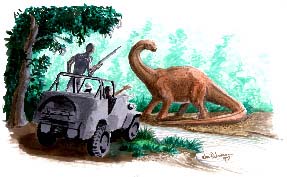
Mokele-mbembe, sauropod-like, are reported to be “reddish-brown to gray.” South American dinosaur-like creatures are merely said to be “dark.” Some Chinese “living dinosaurs,” said to look like hadrosaurs, are characterized as “black.”
What do you think?
Mokele-mbembe art courtesy of Bill Rebsamen. Click on images above for larger views.
Thanks to Darren Naish for sharing his groups of dinosaur replica images above.
About Loren Coleman
Loren Coleman is one of the world’s leading cryptozoologists, some say “the” leading living cryptozoologist. Certainly, he is acknowledged as the current living American researcher and writer who has most popularized cryptozoology in the late 20th and early 21st centuries.
Starting his fieldwork and investigations in 1960, after traveling and trekking extensively in pursuit of cryptozoological mysteries, Coleman began writing to share his experiences in 1969. An honorary member of Ivan T. Sanderson’s Society for the Investigation of the Unexplained in the 1970s, Coleman has been bestowed with similar honorary memberships of the North Idaho College Cryptozoology Club in 1983, and in subsequent years, that of the British Columbia Scientific Cryptozoology Club, CryptoSafari International, and other international organizations. He was also a Life Member and Benefactor of the International Society of Cryptozoology (now-defunct).
Loren Coleman’s daily blog, as a member of the Cryptomundo Team, served as an ongoing avenue of communication for the ever-growing body of cryptozoo news from 2005 through 2013. He returned as an infrequent contributor beginning Halloween week of 2015.
Coleman is the founder in 2003, and current director of the International Cryptozoology Museum in Portland, Maine.

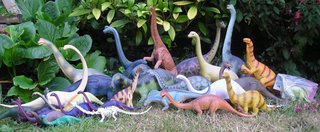
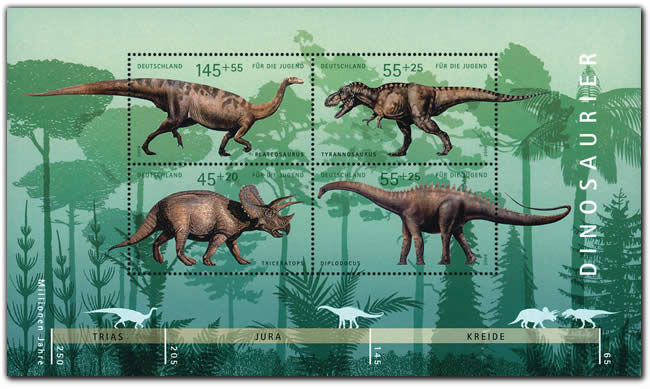

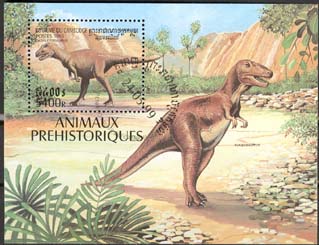

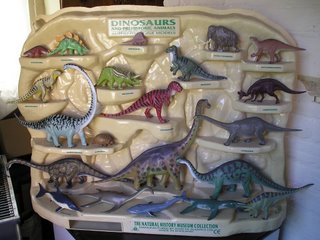
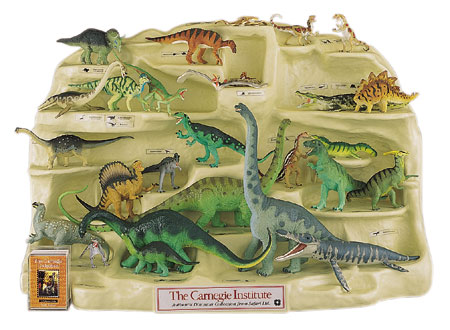
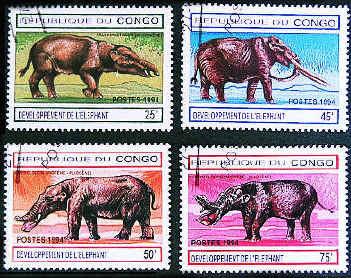
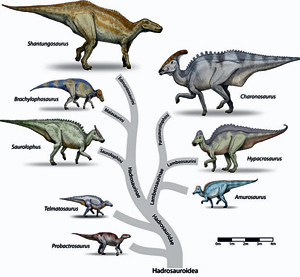
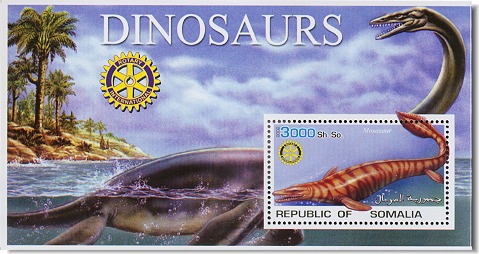

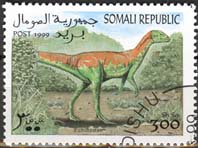
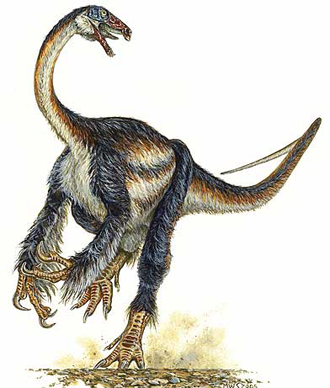
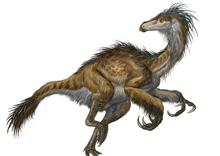
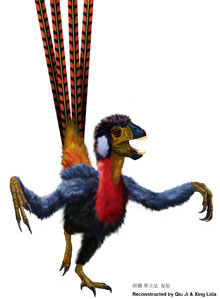
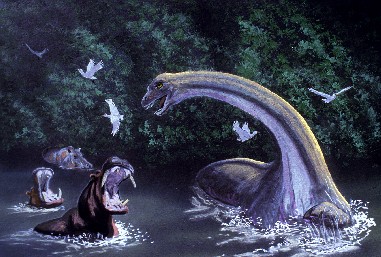
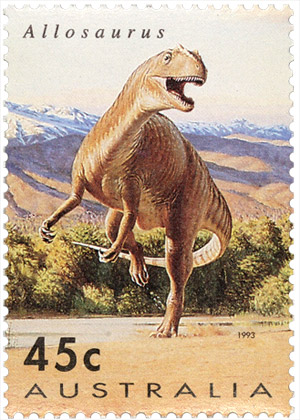









Nice piece. Lets just hope evidence of a real, still living dinosaur turns up in order to answer that question
I think it’s fun to speculate, Loren.
As one of your readers said in the toy collection post, the dinosaurs were a diverse and varied group. Some may have been plain gray or brown, some with patterns of stripes, bands, spots and mottling, and some with brighter color elements.
Of course we would start with the eyewitness accounts, which are brown, gray, green, dark/black (of course color terminology can very by culture and is not always precisely translated– there is often one word for green and blue in some languages, such as the Navajo).
If there are living dinosaurs, then they are likely colored in such a way as to blend into deep forest vegetation cover. This still might be quite varied, as look at the okapi, the panda, the tiger, the leopard, the Indian elephant, the peacock, jungle fowl (chicken), crocodile, boa, tapir, etc. Even an elephant can remain unseen from a very short distance in thick jungle.
I have to agree that dinosaurs were colored pretty much like modern lizards, snakes and birds. Some lizards and snakes have very pretty coloration and patterning, but the larger they get, the duller the colors tend to be (anaconda, boa, marine iguana as opposed to smaller vine snakes and chameleons). The largest birds like the ostrich, cassowary, herons, can be very attractively colored as well, but are not as brightly colored as smaller birds. However on the large birds there can be small parts with bright color on the bare skin; the cassowary has a bright blue neck with red wattles.
The dinosaurs that live around me are covered in feathers of a wide variety of colors and patterns, although the larger ones (kites and ravens) tend to be less bright than the smaller ones (finches). But I suppose you are speculating on the “non-bird” dinos.
Well, the thing to remember about this is that most dinosaurs were not all that large – most species of dinosaurs were actually around the size of a pony or smaller. It is these dinosaurs – the maniraptorans, coelurosaurs, and early therizinosaurs, just for example – that we can expect to have very bright coloration. Furthermore, the only very large mammals we have left are herbivores, so we have no modern evidence to go by when guessing what color large predators like Allosaurus fragilis or Tyrannosaurus rex were, so it’s probably safest to go to the next size category when looking for modern coloration examples, which means that it may be quite likely that T. rex was dark green with [very] dark red striping.
I can remember reading an article several years ago speculating that the South American pterosaur, Pterodaustro may have been pink. Apparently, this pterosaur had long slender teeth in it’s lower jaw that resembled the filter fibers in the bill of flamingos. If the speculations are correct, they could have eaten tiny shrimp as modern day flamingos do and if the shrimp pigment was the same as it is now, theoretically you could have a pink pterosaur.
The habits and coloration of living dinosaurs are exactly as they are portrayed in the popular science the witness has seen. When Mokele-mbembe was first studied as a possible living dinosaur, sauropods were thought to be grayish swamp-dwellers up to their shoulders in water, and that’s exactly what they looked like. Now that there are so many shows with brightly colored, active CGI dinosaurs, many with feathers, I have no doubt the eyewitness accounts will follow suit.
“I can remember reading an article several years ago speculating that the South American pterosaur, Pterodaustro may have been pink. ”
Um, if any aquatic dinosaurs turn out to be pink and white, we all may have made a tragic photograph misidentification. 🙂
-Fhqwhgads: You’re forgetting that the people in the Congo didn’t have the same access that everyone over on this side of the Atlantic had to the latest scientific theories – most of them had probably never even heard of dinosaurs.
-Alcalde: Technically, the only truly aquatic dinosaurs are penguins – plesiosaurs and the like weren’t dinosaurs.
Interesting question and answers as well. We might also have to take into account the sex of the critter…whether or not females or males might be different colors in order to attract a mate and what that might constitute…brights or camouflaging.
Also, the hadrosaur comments got me to thinking too…if there was a group of dinosaurs or several different species that could change colors with the environment, not only is it a good survival mechanism, it would also make it harder for people trying to spot them in jungles unless they really came out into the open…just food for thought.
As for aqautics, I would guess the classic lighter underbelly and darker top color for predators…and with critters like Nessie, there have been varying shades and colors reported over the years…and again whether it is related to sexual dimorphism, individual variance, mis-interpretation, or just plain ole personal interpretation, or something else,…guess we won’t know until we have one.
Fhqwhgads: You’re forgetting that the people in the Congo didn’t have the same access that everyone over on this side of the Atlantic had to the latest scientific theories – most of them had probably never even heard of dinosaurs.
No, I’m remembering that the people who brought them the pictures had a very clear idea of what dinosaurs should look and behave like, and that’s exactly what they found.
There’s a reason why double-blinded tests are to be preferred in situations where you can get them — it’s much too easy for a researcher, through body language or tone of voice, to communicate his desires or expectations to the person being interviewed. That’s basically how horses “count”, apparently.
-Fhqwhgads: Oh, well you’ve got a point there – well, they messed up already on that bit..
I tend to think most of them were grayish-green, though some may have had the colors the rest of the animal kingdom had.
Great post. An issue that’s definitely worth pondering. And CryptoInformant 2.0: I did not know plesiosaurs were not dinosaurs. I thought only pterosaurs were like that. Thanks. 🙂
Those ridiculous dino-bird pictures always make me smile…
So I guess the duck billed platypus is becoming a duck, or a maybe a beaver! Or maybe a snake (the males do have venom). Maybe collagen should be seriously considered as the reason for the ‘dino-fuzz’, I mean come on, those pictures just look ridiculous.
Witness accounts of living dinos are dark greys, reds and greens to my knowledge – Mokele Mbembe, N’goubou, Ropens etc. I do agree that the size question is valid in reptiles. Crocodiles, gators and Komodo dragons are all pretty uniformly drab dark grays/greens.
The only acception is Urufere from the Amazon. My friend over there reports that this massive lizard is actually very beautifully colored according to the Waiwai Indians.
One was actually killed by a hunter as it seized one of the peccary he was chasing, but by the time he returned it was in a state of bad decomposition.
If large, undiscovered reptiles or “dinosaurs” exist I think the main factor effecting coloration is going to be metabolic. They would likely have a cold-blooded metabolism, so adult animals would tend to be darker to more efficiently absorb heat from sunlight. Much like the larger reptiles in existence today – alligators, crocodiles, komodo dragons, etc.
Note that young or juvenile animals might have more brightly colored speckling, stripes, etc. that acts like camoflauge, also like the larger existing reptiles – alligators, crocodiles, komodo dragons, etc. This might actually be present in some of the evidence. The figure in the Mansi photo, for instance, seems pretty sizeable and it appears dark gray. The figure in the ABC News or Good Morning America seems to have some striping/speckling in places so it would seem to be more of a juvenile animal. One could argue that this is backed up behaviorally – the figure in the ABC News video appears to behave somewhat like an inquisitive juvenile.
If more brightly colored animals exist one could theorize that they would likely be located in the tropics or sub-tropics, where heat collection isn’t as difficult. I’m not an expert on crocodilians, but that seems to be the case with them. Australian saltwater crocodiles, for example, seem to be a slightly brighter shade of green than American alligators, for instance – possibly due to a warmer habitat. (I could be wrong on this, like I said I’m not an expert.)
Terrell – The bit with the Platypus is just a case of convergent evolution, actually. The bugger’s a very primitive species of mammal that happens to have a few adaptations reminiscent of other animals, because those things helped it survive in its environment. If anything, it’s becoming extinct, though how quickly or slowly, I cannot say.
I just noticed something in the main posting that really doesnt’ surprise me at all, though it is a little disappointing – Scholastic’s argument on dinosaur coloration hasn’t changed much (or at all) since the 1950s – indeed, if you look, neither have most of the books they publish on prehistoric life.
Very interesting post, thanks.
Here in the desert, reptiles color pretty much adapts to the habitat. Even the colorful lizards and other reptiles blend in. Interestingly there is at UNLV a live specimen of the Mojave green rattlesnake. It is nearly pasty white and not albino. This particular specimen is from an area in Utah with a predominance of light sandstone and chalk (gypsum).
I would say this:
The evidence that they may have been brightly colored is neatly balanced out by the evidence that they may not have been.
Although I could go with the supposition that size might matter in this case, and small fast ones might have been more colorful, as camouflage might not be as important a survival mechanism.
Then of course. Speculation on zebra coloration focuses on a survival mechanism: blending individuals in with the mass in a confusing way. No reason some dinosaurs couldn’t have done that to supplement quickness and speed, too.
After the KT extinction event, large animals disappear. A big carnivore wouldn’t find enough to eat, and a big herbivore would probably have been adapted to plants that would not be representative of the new ecosystem. Sorry, I can’t see the sauropods being able to survive a major global upheaval, whatever it was.
If even a medium-sized dinosaur survived, it would have had a size advantage over the remaining birds and mammals and should have radiated to fill many of the newly vacant niches.
Could some of the hen-sized dinosaurs have survived? Of course, even leaving aside the obvious birds = dinosaurs argument, (1) there’s still a lack of evidence that they exist at all and (2) if they did exist, but remained small and localized, they’d be very, very cool to scientists but a disappointment to the public — not really the kind of thing people mounting an expedition to the Congo are usually hoping to find. Sort of like the coelacanth!
Personally I think IF there’s still “Living Dinosaurs” stomping around they may have the same “color palette” as certain other animals.
They may been more “uniform” in color in the distant past but Evolution and Adaptation, particulalrly to modern-day environments, may have necessitated changes in pigmentation.
The idea that all Dinosaurs may have been mainly a dull green or gray and were slow and stupid has been mainly discredited. Let’s leave it in the past, where it belongs. These creatures were colorful, fast and NOT what you think they may have been.
This sounds relevant to the debate over the color of living dinosaurs:
THE MICROBE is so very small
You cannot make him out at all,
But many sanguine people hope
To see him through a microscope.
His jointed tongue that lies beneath
A hundred curious rows of teeth;
His seven tufted tails with lots
Of lovely pink and purple spots,
On each of which a pattern stands,
Composed of forty separate bands;
His eyebrows of a tender green;
All these have never yet been seen–
But Scientists, who ought to know,
Assure us that is must be so…
Oh! let us never, never doubt
What nobody is sure about!
— Hilaire Belloc
Shovelthenos–“If large, undiscovered reptiles or “dinosaurs” exist I think the main factor effecting coloration is going to be metabolic. They would likely have a cold-blooded metabolism, so adult animals would tend to be darker to more efficiently absorb heat from sunlight.”
It is generally agreed upon that dinosaurs or at least some dinosaurs were not cold blooded. Though they were reptiles the way they lived and functioned is more like that of present day birds and mammals and it is best to look to them for clues on how the dinosaurs lived, especially birds but obviously a bird finch is a very different animal from a triceratops, but then we have rhinos to look at for that sort of comparison. I imagine the larger herbivores were most likely dull, like modern large mammals. Crested hadrosaurs and certopsians may have had display colors on their head ornamentation. Carnivores were likely camouflaged, smaller species may have been colorful.
Terrell–“Those ridiculous dino-bird pictures always make me smile…
So I guess the duck billed platypus is becoming a duck, or a maybe a beaver! Or maybe a snake (the males do have venom). Maybe collagen should be seriously considered as the reason for the ‘dino-fuzz’, I mean come on, those pictures just look ridiculous.”
Evidently this is a comment made from someone who just is not familiar with the fossil evidence for feathered dinosaurs. Current finds go way beyond dino fuzz and into secondary feathers extending from the arms and display feathers on the tails. Species such as Microraptor were gliding animals with wings on all four limbs. You may see them as ridiculous but they were real, like it or not.
It stuns me, looking at some posts, to see the strong resistance to change as far as public opinion about dinosaurs goes. They haven’t been seen by science in general as giant, sluggish, cold-blooded lizards since Ostrom described Deinonychus antirrhopus, and yet – as demonstrated by both Scholastic and, apparently, Shovthenos – people still have a tendency to view them that way.
It is generally agreed upon that dinosaurs or at least some dinosaurs were not cold blooded.
One of the most interesting (to me) departures from the biology I learned in elementary school is precisely this division of animals into warm-blooded and cold-blooded, with birds and mammals being warm-blooded and reptiles, amphibians, and fish being cold-blooded. But some mammals (such as the naked mole rat, and if I remember correctly, to a lesser extent the manatee) are barely warm-blooded at all. On the other hand, the tuna is a “warm-blooded” fish. The distinction is not as black-and-white as it used to be. Besides, a large sauropod probably had a low metabolism (to reduce how much it had to eat, to allow the food to ferment in its stomach, and because it did not need to run from predators) but would still be more challenged with getting rid of heat than with generating it.
But perhaps the best illustration of the difference between the traditional picture of dinosaurs and recent thinking is given by this website.
I have no clue as to what color dinosaurs could be. But I would just about bet money that, they taste or tasted, just like chicken.
maslo63-
Though they were reptiles the way they lived and functioned is more like that of present day birds and mammals and it is best to look to them for clues on how the dinosaurs lived, especially birds but obviously a bird finch is a very different animal from a triceratops, but then we have rhinos to look at for that sort of comparison.
Well first of all I phrased it undiscovered reptiles and put “dinosaurs” in quotes. I’m aware of some of the research suggesting that some dinosaurs might have had metabolisms closer to warm-blooded.
However most of the evidence I have seen hews to the old cold-blooded model. At Champlain you start getting sightings when the temperature rises to 70 or so in the spring and then they drop to zero when the temperature goes below 70 in the fall. (This observation first made my Dennis Hall, I believe.) That follows the model of a cold-blooded animal that hybernates, like the smaller known reptiles at Champlain.
The other sightings of “living dinosaurs” seem to be in very warm tropical or sub-tropical areas, so that doesn’t disagree with the cold-blooded model. That doesn’t rule out warm-bloodedness, though.
CryptoInformant 2.0 –
See the reply to maslo63.
Interesting question, but more for what it reveals about human perception than the actual answer. The fact that we wonder about what color they were, instead of what they smelled like. or what frequency or amplitude of its infrasonics, or …well, you get the picture. We obsess over vision because of our species’ particular evolutionary path which as arboreal primates was an obsession with the color of relatively nearby and reachable fruit or insects, so we see in color and are best at about 100 feet or so. Other animals have some color sensitivity but it seems to be for specific colors relevant to their existence, but who can doubt that the fanciful stripes and polka-dots we see on many replicas are all about making us the prey to commercial market hunters for dinosaur tchochkes.
I’ve heard there’s been some progress in reading the texture of some fossil skin impressions which suggest that there was some micro-structure indicative of coloration (structural color or melanin pigments I can’t recall). None of this speculation dissuades me from wishing we could at least send a camera back in a time machine to see for ourselves, even if we can’t go ourselves. In the mean time I’ll continue to rely on the internet for my armchair time travelling and prehistoric sightseeing, in large part thanks to Cryptomundo. cheers.
PS…Flqwtfghads’ suggestion in his previous comment for further exploration on evolution is possibly the most enlightening and light hearted (side-splittting) bit of educational material referenced so far. Thanks for that.
Shovethenos – Well, if you’re talking specifically about non-dinosaurian reptiles like monitor lizards, then you are correct, those are, as far as we know, cold-blooded. As plesiosaurs were likewise members of the Squamata, it is certainly a possibility that they were cold-blooded as well. However, cross-sections of dinosaur bones, as well as the light, agile build of many of the Maniraptoran dinosaurs, suggests warm-bloodedness for dinosaurs, Theropods in particular. As for the tendency for sightings to be in tropical areas, this may be because of the dense cover that a rainforest provides.
Glendoor – If you manage to catch and kill a living dinosaur, please send me a sample of the resultant barbecue. 😀
Dogu – Well, there is some speculation regarding smell – I think T-rex smelled terrible, personally.
I have found 3 instances from different cultures and times that reference a dragonlike creature with a white ring around its neck, one was Native American, one was Middle Age Europe and another more modern day Asia
There is a growing opinion that the dromaeosaurs at least, -were- birds. That they have been mis-classified. Just as the ‘mammal-like dinosaurs’ may simply have been monotremes, along with the pterosaurs. Birds show up in the fossil record at least as early as dinosaurs. Should others be more correctly classified with turtles and other archaeosaurs? The coloration could vary for all of the reasons the article suggested. For the large predators we might look at the eagles, condors and vultures. T-Rex didn’t have long enough ‘arms’ or winglets to groom his head and neck, so they might have been featherless in those regions, must like a vulture.
The dinosaurs proper had hollow bones and other indicators of being warm-blooded, and belonging to aves, not sauria.